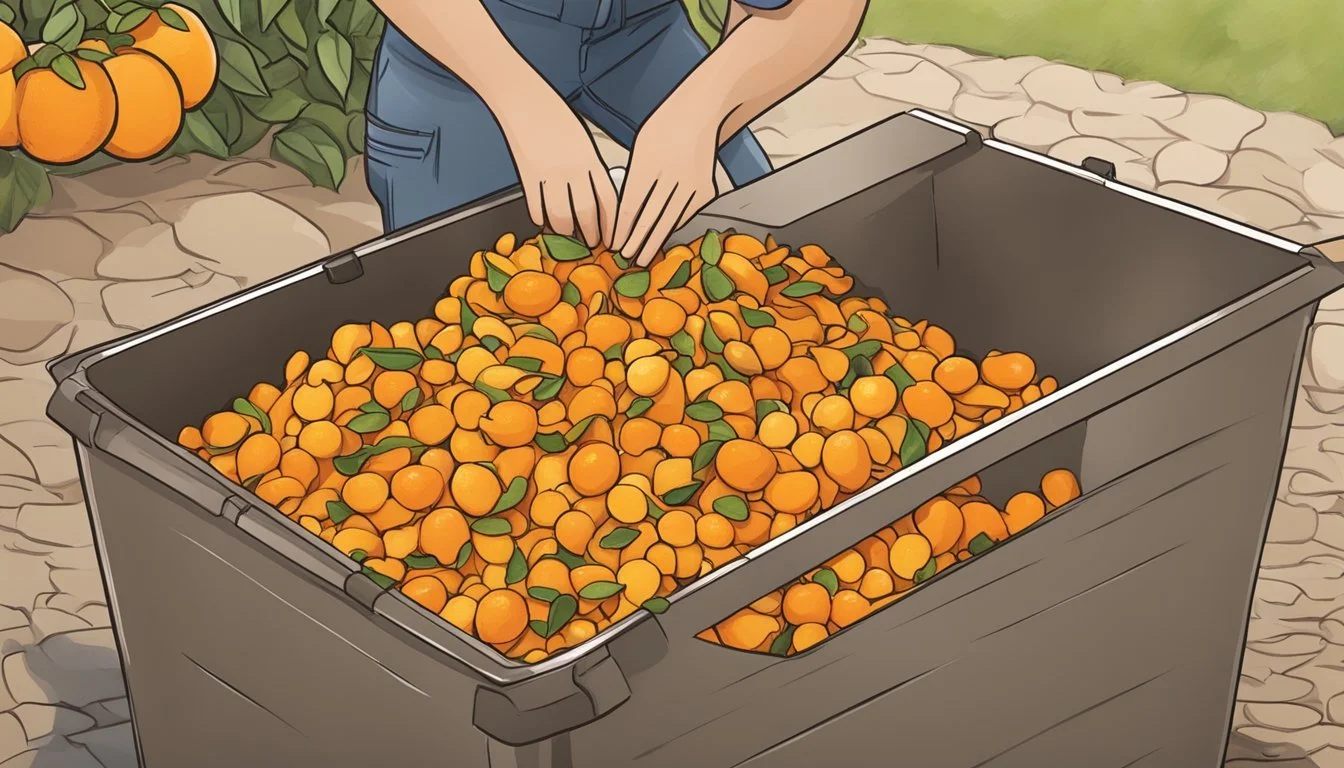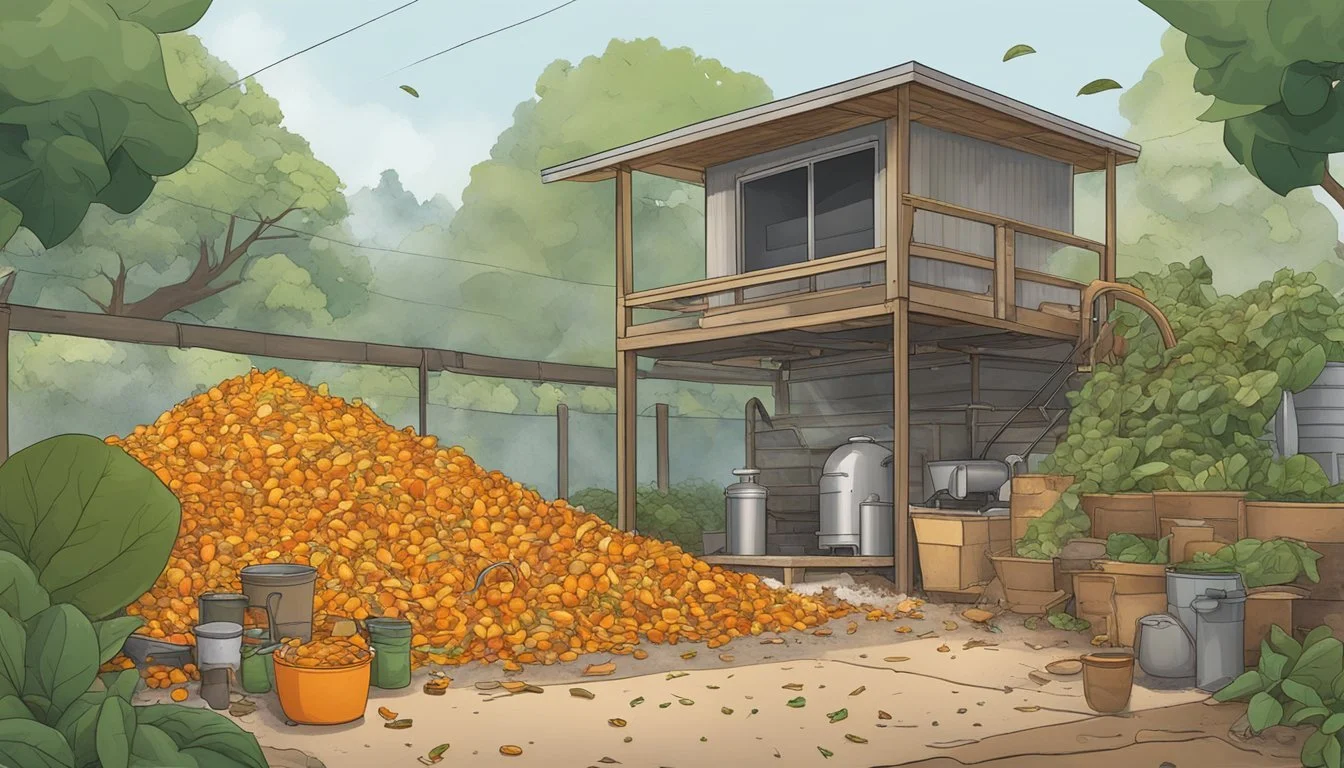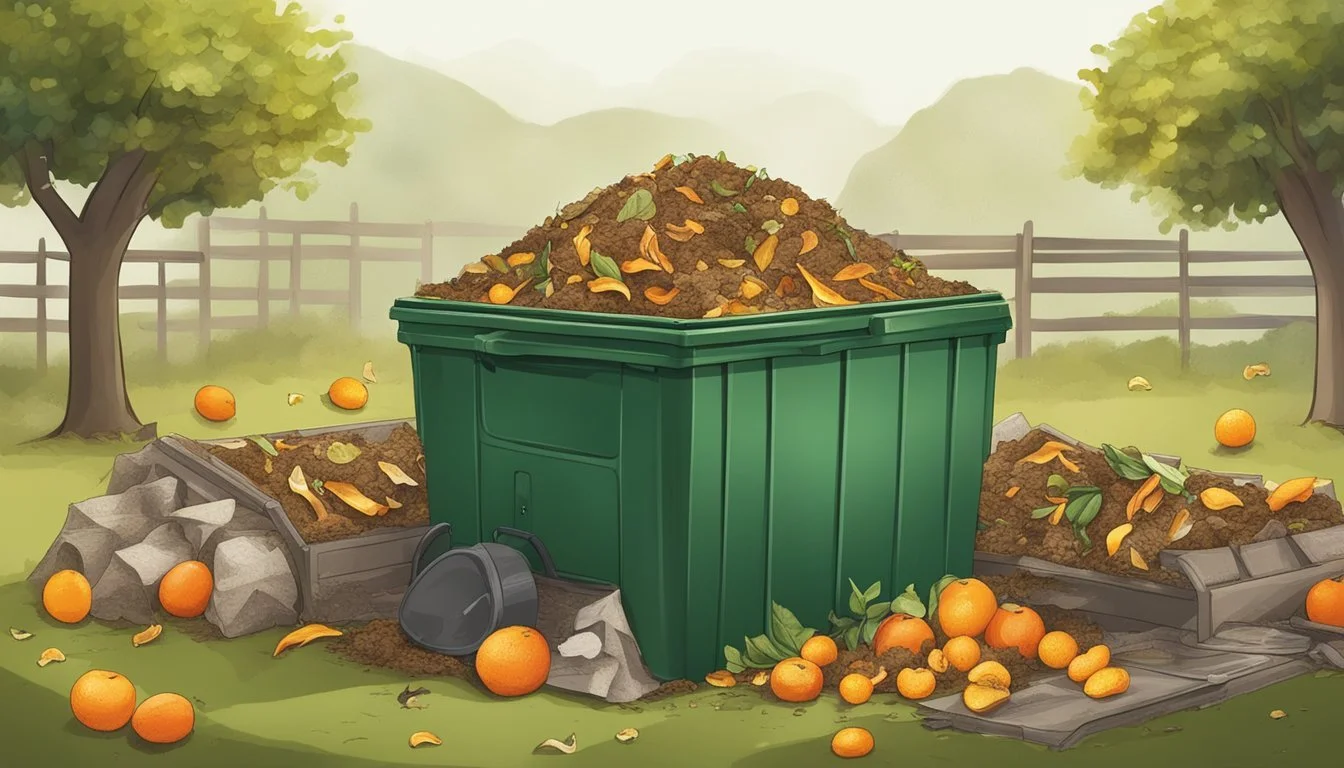Can You Compost Kumquat Peels?
Unveiling the Facts
Composting is a natural process that transforms organic waste into nutrient-rich soil, and it's a key component in sustainable gardening and waste reduction efforts. When it comes to composting kumquat peels, gardeners can confidently add these citrus rinds to their compost piles. Like other citrus peelings, kumquat peels are rich in carbon and contain essential oils that can benefit the composting process by attracting beneficial microbes, which aid in the breakdown of organic matter.
However, it is crucial to balance the addition of kumquat peels with other green and brown materials to maintain a healthy compost mixture. Moderation is key, as excessive amounts of citrus peels can potentially slow down the composting process due to their high acidity and essential oils. It is recommended to chop or shred the kumquat peels into smaller pieces to accelerate decomposition and evenly mix them into the compost pile to avoid creating any overly acidic zones.
Incorporating kumquat peels into compost is more than just feasible; it is advantageous for creating a diverse microbial environment within the compost heap. These citrus peels contribute to the overall health of the compost, which in turn produces a more fertile and balanced soil amendment for gardens and landscapes. By composting kumquat peels, gardeners not only enhance their soil but also participate in an eco-friendly practice that reduces food waste and its associated environmental impact.
Understanding Composting Fundamentals
Composting is a controlled biological process where microorganisms decompose organic matter into nutrient-rich soil. This section will elaborate on the composting process and its benefits.
Composting Process
In composting, organic materials decompose through the action of microorganisms such as bacteria and fungi. These microbes require moisture, heat, and a balance of carbon and nitrogen-rich materials to thrive. The process generally involves four key stages:
Mesophilic stage: Microbes begin to break down the organic matter, causing the pile's temperature to rise.
Thermophilic stage: Temperature can reach between 104°F and 160°F (40°C and 71°C), ideal for thermophilic microbes that further decompose the materials and kill pathogens.
Cooling stage: As the pile cools down, mesophilic microbes re-colonize, continuing decomposition at a slower pace.
Maturation stage: The final product stabilizes and matures, resulting in compost that is ready to enrich soil.
A properly maintained compost pile will generate heat as a by-product of microbial activity, which is essential in accelerating the decomposition process.
Benefits of Composting
Composting offers multiple environmental and practical benefits:
Soil Improvement: Compost introduces vital nutrients and improves soil structure, which enhances plant growth and health.
Waste Reduction: It reuses organic waste, reducing the amount sent to landfills.
Environmental Protection: Composting can aid in sequestering carbon in the soil, mitigating greenhouse gas emissions.
Effective composting requires a balanced environment that supports the lifecycle and work of microorganisms. By understanding and managing the composting process, one can convert organic waste into a valuable end product that benefits the garden and the environment.
Composting Citrus Peels
Composting citrus peels provides a rich source of nutrients and organic matter, but it also presents specific challenges due to their unique properties.
Citrus Peels in Composting
Citrus peels, such as those from kumquats, oranges, and lemons, are an excellent source of carbon in a compost pile. They are classified as 'browns' in compost parlance, necessary for balancing out the 'greens,' which are nitrogen-rich materials like vegetable scraps and grass clippings. Citrus fruit peels contribute to the intricate balance between these two types of compost materials, thereby enriching the resulting compost. However, it is crucial to shred the peels or break them down into small pieces to speed up the composting process, as their tough and waxy exterior can take longer to decompose.
Citrus peels also come packed with essential oils and volatile compounds like d-limonene, which can be beneficial as these compounds may add to the overall acidic nature of the pile, helping to suppress some harmful bacteria and pests. Despite concerns about acidity, most composting action tends to neutralize pH over time. Moreover, the acid they contain is not strong enough to significantly alter the compost's pH level adversely.
Challenges with Citrus Peels
The integration of citrus peels into a composting system does, however, introduce certain challenges. The acidity of the peels, along with their essential oils and volatile citrus compounds, can potentially disrupt the microbial balance within the compost pile. These disruptions might manifest as a slower decomposition process or difficulties in maintaining a healthy population of microorganisms and worms.
Another factor is the potential growth of undesirable fungi. Citrus peels can encourage the emergence of economic fungi such as penicillium, which, while a part of the natural ecological balance, can have adverse effects if it comes into contact with plants, causing damage or disease.
To mitigate these challenges, one should not overload the compost with citrus peels and should maintain a consistent mix of browns and greens to ensure a balanced compost pile. The toughness of citrus peels may require them to be mixed with softer organic matter to decompose effectively. They should be well-integrated with other compost materials rather than layered, which could attract fruit flies or cause mold growth due to restricted airflow.
Lastly, there's a need for patience when composting citrus peels, as the - d-limonene they contain could lengthen the decomposition time. Decompaction methods such as turning the pile frequently can help to aerate it and assist in breaking down the citrus peels more efficiently.
Kumquat-Specific Considerations
The distinctive nature of kumquat peels, which are both sweet and edible, presents unique considerations when composting. This section explores their composition and how they can be effectively incorporated into compost.
Kumquat Composition
Kumquat peels are rich in essential nutrients, containing notable amounts of calcium, magnesium, and potassium—all of which are beneficial to soil health. The small fruit's skin also includes a layer of antimicrobial wax, which can help deter pests. However, because of their acid content and existing seeds, kumquat peels decompose differently from other citrus peels.
Nutrients Presence in Kumquat Peels Calcium High Magnesium Moderate Potassium High Iron Moderate Phosphorus Low to Moderate Sulfur Moderate
Composting Kumquat Peels
When composting kumquat peels, it is important to consider their organic status. Peels from kumquats that have been exposed to pesticides should be cleaned or ideally avoided to protect compost health. The acidic nature of kumquat peels can be balanced by incorporating organic materials like leaves or grass clippings that neutralize pH levels. Cutting the peels into smaller pieces can also accelerate the composting process, ensuring a more even breakdown.
Acid: Balance with alkaline materials.
Seeds: Remove to prevent unintended growth.
Antimicrobial Wax: May slow decomposition; stir compost to aid breakdown.
Optimizing Your Compost Mix
A well-optimized compost mix requires a delicate balance between various elements to nurture beneficial decomposition agents and create fertile, nutrient-rich soil.
Maintaining Balance
The golden rule for an effective compost pile is to maintain an appropriate balance between nitrogen-rich 'greens' and carbon-rich 'browns'. Kumquat peels, classified as greens, are high in nitrogen, stimulating bacteria and promoting speedy decomposition. For optimal compost health, aim for a carbon to nitrogen ratio of roughly 30:1. Sources of carbon include:
Twigs
Wood chips
Cardboard
Dry leaves
In contrast, suitable nitrogen sources may consist of:
Kumquat peels
Coffee grounds
Manure
Grass clippings
Maintaining a balance in the compost not only aids in decomposition but also helps to conserve the right level of moisture and temperature, both critical for composting effectively. Additionally, this balance prevents overly acidic soil conditions, which can be harmful to plants.
Accelerating Decomposition
To speed up the composting process, incorporating techniques that boost microbial and worm activity is crucial:
Aeration: Regularly turning the compost introduces oxygen, crucial for aerobic bacteria. These microorganisms break down organic mulch and scraps more efficiently when oxygen is abundant.
Additives: Items such as coffee grounds and manure can be added to introduce more nitrogen into the compost, energizing the decomposing agents.
Moisture Control: Keeping the compost damp but not waterlogged supports necessary bacteria and worms while preventing an overabundance of acidity.
Temperature Monitoring: A warm compost pile, ideally between 135-160 degrees Fahrenheit, will aid in faster decomposition without killing beneficial organisms.
Monitoring pH balance is also part of optimization. While kumquat peels are acidic, a well-balanced compost should self-neutralize. However, if the mix is disproportionately acidic, adding crushed eggshells or garden lime can rebalance the pH.
Growing Kumquats with Compost
Growing kumquats can be a fruitful endeavor when utilizing compost, as it enriches the soil with nutrients essential for healthy citrus trees. Proper integration of compost into the cultivation process can promote robust growth and increased resistance to pests and disease.
Using Compost in Kumquat Cultivation
The kumquat tree thrives in nutrient-rich soil that provides adequate sustenance for its growth. Incorporating compost into the garden bed enhances the soil's fertility, providing a balanced mix of essential nutrients. It is recommended to:
Mix compost into the topsoil around the kumquat tree at least twice a year.
Ensure the compost is well-aged to prevent the introduction of diseases.
Compost aids in water retention, which is critical for kumquat trees, especially during periods of drought. The compost's organic matter slowly releases nutrients into the soil, which the kumquat tree's roots absorb over time. Citrus trees, such as kumquats, can also benefit from additional fertilization methods, such as fish emulsion or liquid kelp, to provide a more immediate nutrient boost.
Kumquat Tree Care Tips
The care of kumquat trees goes beyond simple soil enrichment. To maintain a healthy tree capable of resisting common ailments like mealybug, Armillaria root rot, anthracnose, and citrus blast, gardeners must adhere to the following practices:
Watering: Kumquat trees require consistent watering to prevent stress, especially in full sun environments. Keep the soil moist but not waterlogged.
Sunlight: Place the tree in a location where it will receive full sun for optimal flowering and fruit production.
Pest management: Use organic pesticides if pests are detected. Regular inspection is key to early identification and control.
Nutrient balance: Fertilize strategically with balanced fertilizers to avoid excessive nitrogen, which can lead to lush foliage at the expense of fruit production.
For liquid fertilizer applications, which can include products such as fish emulsion, it is crucial to follow the manufacturer's guidelines regarding dilution and frequency to avoid over-fertilization and potential damage to the tree.
By using compost in combination with thoughtful cultivation practices, gardeners can significantly improve the health and yield of their kumquat trees.
Environmental Impact and Considerations
Composting kumquat peels contributes significantly to environmental sustainability efforts by reducing organic waste and promoting soil health.
Reducing Waste
Composting is a practice that reduces the amount of waste sent to landfills, where organic matter decomposes anaerobically, releasing methane, a potent greenhouse gas. By composting kumquat peels, individuals can divert this organic material from the waste stream, thereby lowering their environmental footprint. This process also produces nutrient-rich compost that benefits the soil ecosystem, reducing the need for synthetic fertilizers.
Benefits of Composting Kumquat Peels:
Lowers volume of landfill waste
Reduces methane emissions
Provides nutritious compost for gardening
Organic vs. Inorganic
Kumquat peels are classified as organic waste, which can be broken down by microorganisms, insects, and earthworms into compost. This organic matter falls into the "greens" category—rich in nitrogen—which should be balanced with "browns" (carbon-rich materials) for optimal composting. Inorganic matter, in contrast, does not decompose and can contaminate the compost.
Balancing Greens and Browns:
Aim for a ratio of 1 part greens (like kumquat peels) to 3 parts browns.
Example Browns: dry leaves, straw, paper.
It is crucial to consider the moderation of greens added to compost, as too many can lead to a wet and smelly pile. During the spring and winter months, the rate of decomposition often changes, and additions to the compost should be adjusted accordingly. Organic composting practices support the proliferation of beneficial organisms such as earthworms, essential to healthy soil structure.







